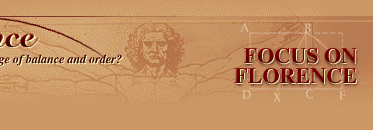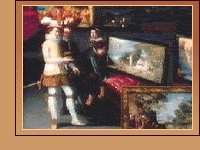  |
 The Renaissance was a rebirth that occurred throughout most of Europe. However, the changes that we associate with the Renaissance first occurred in the Italian city of Florence and continued to be more pervasive there than anywhere else. The city's economy and its writers, painters, architects, and philosophers all made Florence a model of Renaissance culture. Fifteenth-century Florence was an exciting place to be. In 1425 the city had a population of 60,000 and was a self-governed, independent city-state. Twelve artist guilds that regulated the trades were the basis of Florence's commercial success. Members of the guilds, who were wealthy and held positions in government, were some of Florence's most influential people in society and politics. Because of its strong economy and a political philosophy that was dedicated to the welfare of the city, Florence thrived.
The most powerful guilds were those that represented textile workers. Much of Florence's wealth was dependent on the manufacture or trade of cloth, primarily wool. Wool of superior quality was often purchased unfinished and untreated from England and Iberia. Florentine textile workers then cleaned, carded, spun, dyed, and wove the wool into cloth of excellent quality. They sold the finished material in Italy, northern European cities, and even in eastern countries. Other textile experts purchased inferior cloth from northern cities and refinished it to create a superior product. Because Florence was not a port city like Venice, sea trade was not a primary source of its income. Banking, however, was. Many families of Florence, beginning in the thirteenth century, were successful bankers. The Florentine gold coin known as the florin was of such reliable purity that it was the standard coinage throughout Europe. Florentine bankers were known throughout Europe as well, for they established banking houses in other important cities such as London, Geneva, and Bruges (Belgium). The Palazzo Vecchio, constructed in 1299, was the home of the Florentine guilds. Then, as well as today, it functioned as the seat of municipal government and the heart of Florentine culture. It was here that the city's 5,000 guild members, who had the power of the vote, gathered to discuss and determine city issues. In addition to textile workers and bankers, the guild members included masons and builders, sculptors, lawyers, and solicitors. Read more about life in Florence. Read about Florentine art and architecture. | |||
